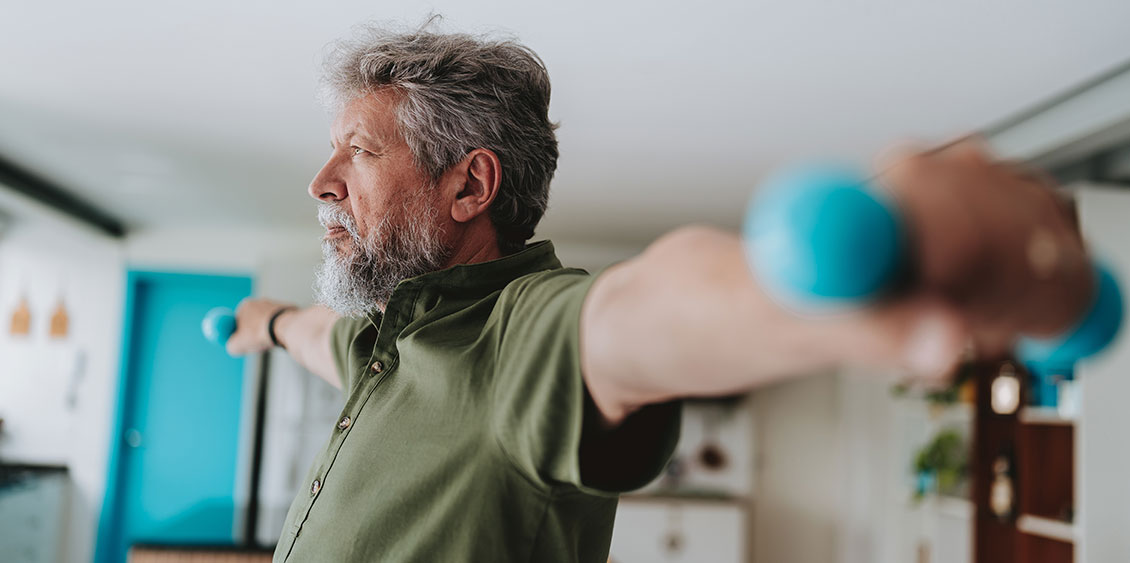Men experience a gradual decline in testosterone levels at certain stages of life, notably starting in their mid-forties. While this is a natural phenomenon, it can trigger disruptive symptoms. Here are the signs and causes of andropause in men, plus treatment options to help manage its symptoms.

What is andropause?
The term “andropause” describes age-related androgen deficiency (or late-onset male hypogonadism). In concrete terms, testosterone levels slowly decrease as men age. Production doesn’t stop overnight, but a number of changes do occur that can affect men in different ways. Some will barely notice, while others will experience more symptoms.
When does andropause begin in men?
On average, onset tends to occur after 50, but andropause can begin before the age of 45. A person’s overall health and lifestyle habits, as well as certain health problems, can affect its severity.
What changes do men undergo at 50?
Around age 50, testosterone and metabolism begin a gradual decline, slowing recovery, decreasing muscle mass, and possibly increasing waist circumference. The prostate may enlarge, sometimes weakening the urine stream and increasing nighttime urination.
Important: If you notice any of these symptoms, ask your doctor for a checkup to confirm the cause. While andropause is a natural phase in a man’s life, it’s still important to make sure these changes aren’t linked to a health problem.
How long does andropause last?
Testosterone can drop slowly over a period of several years. The good news is that certain conditions known to decrease testosterone, such as excess weight, sleep apnea, alcohol consumption, sedentary lifestyle, and medication, are reversible. When corrected, testosterone levels can rise and the associated symptoms resolve.
Is andropause a disease?
No. Andropause is a natural phenomenon linked to hormonal aging. It becomes a cause for concern if decreased testosterone levels lead to symptoms that hinder well-being or health (e.g., reduced muscle mass, anemia, reduced endurance when exercising, unusual fatigue).
What are the symptoms of andropause in men?
In general, men can experience diminished sex drive, erectile dysfunction, persistent fatigue or lack of energy, hot flashes, less restful sleep, reduced muscle mass and stamina, and an increase in waist circumference. They may also become more irritable and struggle with motivation.
Note: Andropause only affects men. Women go through menopause rather than andropause, and while the symptoms are similar, their management differs. Regardless, symptoms could be caused by other conditions and lifestyle habits, including health problems (diabetes, thyroid disease, depression), sleep apnea, anemia, certain medications (e.g., opioids, corticosteroids), alcohol consumption, and smoking.
Is male andropause comparable to female menopause?
Menopause is an abrupt cessation of hormone production in women that ends their fertility. Andropause, on the other hand, can be gradual and doesn’t necessarily affect a man’s fertility. Some symptoms are similar (hot flashes, disturbed sleep, mood swings), but its course and management are not the same.
How is andropause diagnosed?
Diagnosis begins with discussing your symptoms, lifestyle, medications, and health history with a health care professional.
To diagnose, your clinician will measure your testosterone levels early in the morning, ideally twice. Your doctor will also assess any associated pathologies and conditions that may be decreasing your testosterone as these conditions can be corrected and help testosterone levels return to normal. Decisions will be made in collaboration with your doctor, who will provide clear and direct explanations.
What treatments are available to help me live better with andropause?
You’ll need to look closely at your daily habits and make some lifestyle changes to counter the effects of andropause as effectively as possible. A few simple changes can improve your health and help you get through this period of life.
- Regular physical activity (ideally a bit of weight training and cardiovascular training) to help rebuild muscle mass and support libido and mood
- Balanced diet (proteins, fibre, healthy fats)
- Regular sleep
- Reduced alcohol and tobacco consumption
- Stress managment exercises, such as yoga
Treatment options include testosterone therapy, which can help some middle-aged men with specific symptoms and confirmed androgen deficiency. This therapy requires medical supervision with regular follow-up (symptoms, blood tests, prostate evaluation) as it is not suitable for everyone.
Good to know: In cases of known or suspected prostate cancer, options will be carefully reassessed. Your pharmacist can also help you develop a plan, review your medications, and suggest safe modifications.
4 tips for andropause
- Move your body
Get more exercise. Aim for strength training 2 or 3 times a week along with some cardiovascular training to support muscle mass, improve endurance, and increase energy. - Get quality sleep
Maintain a regular routine and limit screen use in the evening. Snoring or constant fatigue may suggest sleep apnea, so don’t hesitate to consult a health care professional to find out if you have this condition. - Support your hormonal balance with diet
Be sure to get the vitamin D and calcium you need. A balanced diet helps manage gradually declining testosterone levels. - Reduce triggers
Manage your stress, moderate alcohol consumption, stop smoking, and reconsider habits that decrease energy or trigger hot flashes. Small changes can often make a big difference.
If you have any questions, don’t hesitate to talk to your pharmacist.
Last updated on September 23, 2025
Other articles that might interest you

